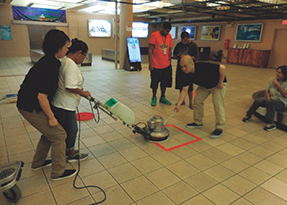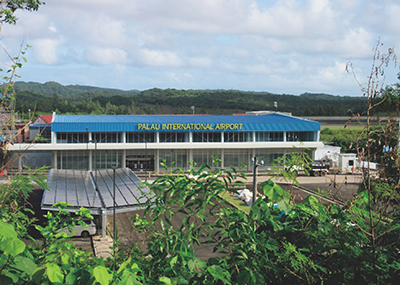Stories from the Field 2
Japanese Companies Forge Ahead with Palau Airport Project
—An all-Japan initiative contributing to the development of Palau’s tourism industry—

JAT giving guidance on cleaning (Photo: PIAC)

The new terminal under construction (January 2021) (Photo: PIAC)
In Palau, the tourism industry accounts for over 70% of its GDP, and tourism supports the country’s financial and industrial sectors. However, due to a rise in the number of tourists since 2015, the number of passengers using the country’s only international airport, Palau International Airport, has been exceeding the capacity of available airport facilities, causing issues such as long lines at immigration and check-in counters at peak times. The expansion of airport facilities and operational improvements are therefore crucial in the continued development of Palau as a tourism-oriented country.
To resolve these issues, Japan has been implementing the “Renovation, Expansion and Management of Palau International Airport Project” in Palau since 2019.
This project is a joint venture between Sojitz Corporation, a company with a wealth of knowledge on the aviation industry and connections with airlines, Japan Airport Terminal Co., Ltd. (JAT), a company with operational expertise of Haneda Airport’s passenger terminals and an excellent reputation internationally, and the Japan Overseas Infrastructure Investment Corporation for Transport & Urban Development (JOIN). The project was launched thanks to a boost from financing under JICA’s Private-Sector Investment Finance (PSIF) scheme*1; the first implementation of the PSIF in the Oceania region. Upon embarking on the project, Sojitz and JAT first deepened their investigation via a JICA preliminary survey, and after that, Sojitz, JAT, and JOIN established a local airport operations company called Palau International Airport Corporation (PIAC) with the Government of Palau. Since then, renovation and expansion of the existing terminal at Palau International Airport is being carried out alongside operation and maintenance work, and know-how on airport operation is being passed onto Palau, all through PIAC. The existing terminal, which is currently under renovation, was itself originally constructed in 2003 with Grant Aid from Japan, and it is Japan’s consistent support that has led to the development of the present project.
Mr. ASAEDA Masahiro, formerly on secondment to PIAC from Sojitz, talks about the circumstances that led to the project’s implementation as follows: “Sojitz and JAT have long had a keen interest in engaging in airport operations both within Japan and overseas. We set our sights on Palau, a country that has a friendly relationship and close ties with Japan, as we would be able to utilize the expertise and networks of each company. I think it was Japan’s previous contribution of support to the country that led to the Government of Palau allowing Japanese companies to implement this project.”
This is the first overseas project for JAT, which is carrying out improvements and providing guidance on the operations of Palau International Airport. In the field, PIAC, Sojitz, JAT, and JOIN are working hand in hand to make steady progress with the project while also facing unforeseen circumstances—namely, delays in renovation works due to the spread of COVID-19—and are being mindful of differences in culture and customs between Japan and Palau.
Mr. TAKEI Ryo from JAT says, “JAT has presented various proposals that cover the entire scope of operational improvements to Palau International Airport. Specifically, we have enforced thorough cleaning practices, improved the installation locations of informational signs, renovated facilities with a view to making them barrier-free, strengthened the cooperative relationship between the airport and its commercial tenants, and arranged the locations of new commercial facilities following the airport’s expansion. We have been sharing our experiences in Japan with PIAC as we progress with the project.”
In addition, Mr. NARITA Mitsuru, Vice President of PIAC (on secondment from JAT) engaging in the on-site implementation of the project, said, “At the onset of the project, employees’ working hours were not being recorded with timecards, and there was no systematic manual on maintaining or cleaning the facilities. We persevered in changing local people’s way of thinking and creating a pleasant working environment to improve operations.”
The project is certainly an all-Japan initiative in that the important issues facing Palau are being resolved by cooperation between the Government of Japan and Japanese businesses. As there has not been any precedent for the privatization of infrastructure facilities in Palau, the project is becoming a catalyst for promoting the privatization of key infrastructure in the country. In addition, the project, which is the first public-private partnership (PPP) infrastructure project*2 in Palau, has become a model case of PPP in the country, as new electrical power projects utilizing renewable energy are now also being considered under a PPP framework with other foreign companies. It is hoped that the project contributes to the economic development of Palau, which largely relies on its tourism industry, by steadily transferring specialist knowledge and technology from Japanese companies to local people, and in turn, increasing the number of passengers using the airport, as well as the number of daily flights. Moreover, it is also hoped that the success of this project will lead to more Japanese companies expanding into Palau.
Japan continues to partner with private companies to overcome the difficulties of COVID-19 and connect the success of this project with further promoting a friendly and trusting relationship between Japan and Palau.
*1 See "Public-Private Partnership Support Schemes Using ODA" regarding details on this scheme.
*2 See "(1) Partnership with Private Companies" regarding details on this system.
<< Previous Page Next Page >>
Main Text | Reference Statistics | Reference Materials | Stories from the Field | Master Techniques from Japan to the World | ODA Topics
